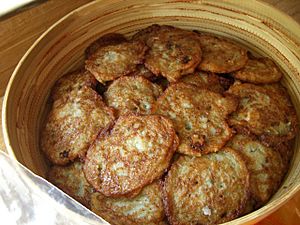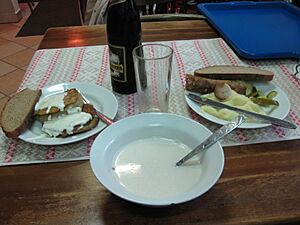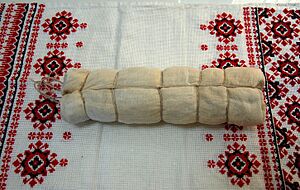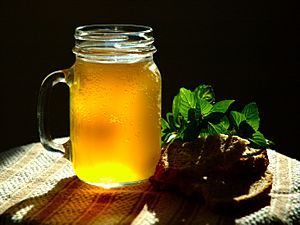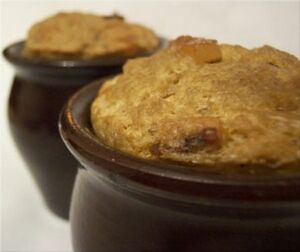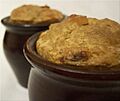Belarusian cuisine facts for kids
Belarusian cuisine is the traditional food from Belarus, a country in Eastern Europe. It's a lot like the food in other nearby countries in Eastern, Central, and Northeastern Europe. The main ingredients are usually meat and different kinds of vegetables that grow well in the region.
Contents
History of Belarusian Food
The roots of Belarusian cooking go way back to the Slavs, who were early people in this region. Over many centuries, Belarusian food also got ideas from Lithuanian and Polish cooking. This happened because people from these areas lived together for a long time, especially during the time of the Grand Duchy of Lithuania (from the 1100s to the 1400s) and later the Polish-Lithuanian Commonwealth (from the 1500s to the 1600s).
Rich families in Belarus, like those in Poland, also learned cooking styles from Italy, Germany, and France. For example, lazanki are a type of flour dumpling with stewed meat, similar to Italian lasagna. Also, many dishes made from grated potatoes became popular, which came from German cooking.
In the 1900s, big changes happened in Belarus. Many old traditions, especially those from wealthy families, were lost. After World War II, people started to rebuild Belarusian culture, including its food. They looked back at what the poorest farmers ate in the late 1800s to create new "traditional" dishes. Today, people are working to bring back even more of the older, forgotten recipes.
Modern Belarusian food still has influences from its recent past. You'll often find dishes from Russia in restaurants. However, some classic Belarusian foods are very popular everywhere. These include draniki (potato pancakes), boršč (beet soup), chaładnik (cold beet soup), mačanka (a meat gravy), zrazy (meat rolls), and bliny (thin pancakes). Sour rye bread is also a common food.
Traditional Meals
In the past, a typical dinner for farmers or merchants usually had just two parts: a soup and a main dish. Farmers' children even used a special pot called a sparysh to bring lunch to their fathers working in the fields. Before World War II, salads and other small snacks were not very common.
However, fresh white cheese and different kinds of cold meats, often smoked, were available, especially during holidays.
Grains and Cereals
Wheat doesn't grow very well in the cold, wet climate of Belarus. Because of this, Belarusians have always loved a slightly sour rye bread. Their traditional strong drink, called harelka, was also made from rye grain.
Like other Slavic people, Belarusians have many kinds of bliny, which are pancakes. They come in different thicknesses, some plain and some filled. They are mostly made from wheat or buckwheat flour, but sometimes also from oatmeal.
Various types of cereals were common, especially barley, oatmeal, and buckwheat. Belarus was a major place for growing buckwheat in Europe. Dishes made with this healthy grain used to be very popular, like different kinds of buns, cakes, and dumplings. Today, mostly kasha (a type of porridge) is still eaten.
Vegetables in Belarusian Cooking
The main vegetables used in Belarusian cuisine were cabbage, often made into sauerkraut, and beets. Other vegetables like turnips, swedes, parsnip, and carrots were also eaten, often stewed or boiled with a little milk.
Legumes, like peas and beans, were an important source of protein. They were often made into a puree called kamy, mixed with melted lard.
Delicious Soups
Even though the word "soup" didn't arrive in Belarus until the 1700s, soup-like dishes have been around for centuries. The old name for most traditional Belarusian soups was poliŭka. Some soups were named after their main vegetable, like kapusta (cabbage soup) or buraki (beet soup).
For a typical poliŭka, the main ingredients, like fish or mushrooms, were first boiled with spices. Then, grains like barley or millet were cooked in the broth. Finally, flour mixed with water, bread kvass, beet juice, or buttermilk was added to thicken it.
Belarusians, like people in Ukraine, Russia, and Poland, enjoy borscht. This is a thick and rich soup made with beets, cabbage, grains, potatoes, and meat. Soups are a very important part of Belarusian food, both hot ones like shchi and boršč, and cold, sour soups that are perfect for hot summers.
The Belarusian chaladnik is a cold beet soup. It's made from beets, beet leaves, or sorrel and served with sour cream, hard-boiled eggs, and boiled potatoes. This refreshing dish has been popular in Poland and Lithuania since the late 1700s.
Meat Dishes
In the past, meat was not always easy to get for most people. It was often eaten mainly on big Christian holidays. Belarusians really like pork, but they eat less mutton and beef.
A very common meat dish was raw pork sausage. This was a pig intestine filled with minced or chopped meat, seasoned with salt, pepper, and garlic. Its old name, "finger-stuffed sausage," described how it was made by hand. Kishka or kryvyanka was a local blood sausage made from pig's blood and buckwheat grain. Škalondza or kindziuk was a special round sausage made from a pig's stomach filled with minced pork and spices. It's similar to the Lithuanian skilandis.
Cold meat rolls, salcesons, and balerons became popular throughout society by the 1800s and are still very much liked today.
Veraščaka is a thick meat gravy with pieces of meat and sausage. It's used as a dip or sauce for thick pancakes and is still a very popular dish in Belarusian restaurants. Today, it's usually called mačanka. Also popular are zrazy, which are pieces of beef rolled into a sausage shape and filled with vegetables, mushrooms, eggs, or potatoes. Pork dishes are often fried or stewed, sometimes with cheese or mushrooms. Beef steaks are also common.
Tasty Dumplings
Kalduny are small boiled dumplings, similar to Russian pelmeni and Italian ravioli. They used to come in many different combinations of dough, filling, and sauce. A very popular type was kalduny Count Tyshkevich, filled with fried local mushrooms and smoked ham.
Later, in the late 1800s, kalduny started to be made with grated potato instead of flour dough. The number of fillings also became much smaller. Today, kalduny are trying to become as popular as they once were, as Russian pelmeni are now more widely known.
Dairy Foods
The main dairy foods in Belarus include a type of fresh white cheese called tvarog and sour cream called smiatana. Sour cream is used a lot in cooking and as a topping for many dishes.
Fermented cheese was first brought to Belarus from the Netherlands and Switzerland in the mid-1800s. A local version of Edam cheese was very popular for many years in the Russian Empire.
Traditional Drinks
A traditional strong drink in Belarus is harelka, which is a type of vodka. Some varieties are made from birch sap (called biarozavik) or flavored with forest herbs (like zubrovka).
Drinks made from honey and spices, like mead, were very common until the 1800s. Now, they are starting to become popular again. A special example is krambambula. This drink is vodka mixed with water, honey, and spices like nutmeg, cinnamon, cloves, and pepper. In the 1700s, krambambula was a fancy drink that only wealthy people could afford. Today, it's making a comeback!
Kvass has always been, and still is, the main local non-alcoholic drink. It's traditionally made from rye malt and natural flavorings, though sometimes it's made with sugar and artificial flavors now. Kompot is also a popular drink, made by boiling dried or fresh fruit and then cooling it. Many small towns in Belarus have their own local mineral water. Belarusians often prefer carbonated (bubbly) water.
Traditional liquid desserts that go with a meal include saladucha, a thick drink made of rye flour and honey that was popular in the 1700s. Another is kissel, a jelly-like drink from Eastern Europe. It's made from forest berries or cooked fruits, and was originally thickened with oatmeal, but now it's often thickened with potato starch flour or cornstarch.
Influences from Other Cuisines
Belarusian cuisine has learned a lot from Jewish cooking. In the 1800s, Jewish influence was especially seen in potato dishes from Germany, like babka. This was a two-way street, as the famous bulbe latkes, which are potato pancakes eaten by Jews in Eastern Europe, might have been inspired by Belarusian draniki.
Another important group that influenced Belarusian food were the Lipka Tatars. Their Tatar cuisine brought many different cakes with fillings, as well as mutton and vegetable dishes.
The Mighty Potato
The potato became incredibly common in Belarus in the 1800s. There are over 300 different potato dishes recorded in Belarus! Because of this, the potato is seen as a core part of the national cuisine. In the past, Belarusians were sometimes even called bulbashi, which is a nickname meaning "potato people."
Fresh Salads
Typical Belarusian salads use a fairly short list of ingredients. You'll find endless mixes of boiled beef or chicken, potato, beet, carrot, apple, herring, diced cheese, canned peas and corn, canned fish, and mushrooms. These salads are often generously seasoned with mayonnaise or sunflower oil.
One very typical local salad is the "Belaya Vezha" salad, named after the Belaya Vezha Forest. It mixes boiled chicken meat with fried mushrooms, onions, and pickled cucumbers. It's mixed with mayonnaise and topped with chopped hard-boiled egg.
Fresh vegetable salads are also widely available. These include tomatoes (often mixed with cucumbers) and onions seasoned with sour cream. You might also find radishes with dill and sunflower oil (or sour cream), shredded cabbage salad seasoned with sunflower oil or mayonnaise (like coleslaw), or pickled cabbage with caraway seeds or cranberries and onions, seasoned with sunflower oil.
Fish Dishes
Historically, Belarusians didn't have much access to seafood, and this is still true in their cooking today. The most common sea fish, after herring, are hake and cod. There are not many dishes made with these types of fish.
Much more traditional and common are fish from lakes, especially zander, which is cooked in many ways. Carp is also popular, especially the famous stuffed carp, which is similar to the gefilte fish of Jewish cuisine. Eels, either smoked or stuffed, are a special dish in the lake region in northwestern Belarus, near Latvia and Lithuania.
Side Dishes
Side dishes are usually boiled, fried, or mashed potatoes. Other common sides include buckwheat kasha, rice, or pasta. Meat dishes are often served with bliny or draniki stacked in round clay pots.
Images for kids
See also
 In Spanish: Gastronomía de Bielorrusia para niños
In Spanish: Gastronomía de Bielorrusia para niños


